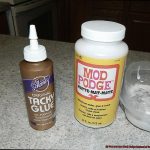Got a rubber and plastic conundrum that needs solving? Wondering if Super Glue can work its magic and bring these two materials together? Well, hold on tight because we’re about to dive into the exciting world of adhesive possibilities.
Super Glue, also known as cyanoacrylate adhesive, is like the superhero of bonding agents. It’s quick-drying, versatile, and boasts some serious bond strength. While it’s typically used for porous materials like wood or fabric, don’t underestimate its power when it comes to gluing rubber to plastic.
In this article, we’ll explore why Super Glue is a fantastic choice for bonding rubber to plastic. We’ll also cover any potential pitfalls you need to watch out for and share some handy tips to ensure your bond stands strong over time. So buckle up and get ready to discover the incredible versatility of Super Glue in tackling those rubber-to-plastic challenges.
What Materials Can Super Glue Bond?
Contents
- 1 What Materials Can Super Glue Bond?
- 2 Challenges of Bonding Rubber and Plastic
- 3 Is Super Glue Suitable for Rubber to Plastic Bonding?
- 4 Compatibility Considerations for Rubber and Plastic
- 5 Best Practices for Using Super Glue for Rubber to Plastic Bonding
- 6 Alternatives to Super Glue for Rubber to Plastic Bonding
- 7 Conclusion
Its remarkable capability to create quick and secure bonds has made it a go-to choice for various projects. But what exactly can super glue bond? In this comprehensive guide, we will delve into the wide range of materials that can be effectively bonded using this versatile adhesive.
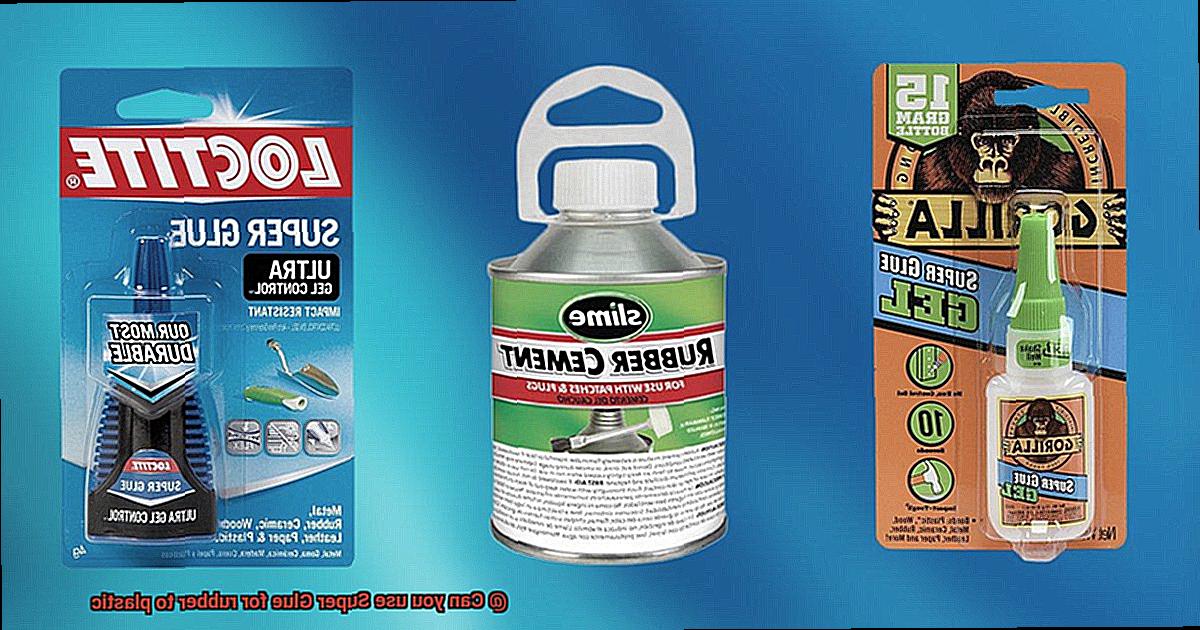
Plastics:
Super glue excels in bonding rigid plastics such as PVC, acrylic, polycarbonate, and ABS. These plastics boast smooth surfaces that readily form robust connections with the adhesive. Whether you’re repairing a broken plastic toy or constructing a model, rest assured that super glue will be your steadfast companion.
Rubber:
Bonding rubber to plastic can be challenging due to the low surface energy of rubber materials. However, with the right combination of rubber and plastic, super glue can still work its magic. Rubber types like neoprene or nitrile may bond well with specific plastics. For more demanding pairings or flexible plastics like silicone or polyethylene, it is advisable to explore specialized adhesives designed explicitly for rubber-to-plastic bonding.
Metal:
When it comes to bonding metal surfaces, super glue shines as an exceptional choice. Whether you’re repairing jewelry or assembling metal parts, this adhesive ensures a sturdy and enduring bond.
Wood:
Woodworking projects often necessitate a reliable adhesive, and super glue fits the bill perfectly. From delicate crafts to substantial furniture repairs, super glue can seamlessly and firmly bond wood materials.
Ceramics:
Have you ever dropped your beloved ceramic mug and watched it shatter into countless pieces? Fear not. Super glue comes to the rescue by seamlessly reuniting ceramic fragments into their original form.
Challenges of Bonding Rubber and Plastic
Bonding rubber and plastic together may seem like a simple task, but the road to a successful bond is paved with challenges. The differences in surface energy, flexibility, chemical composition, contaminants, temperature, and durability all play a role in making this bond a tough nut to crack. In this article, we will delve into these challenges and provide insights into the best adhesive options to conquer this bonding conundrum.
Surface Energy:
Rubber’s lower surface energy compared to plastic makes it difficult for adhesives to form strong bonds. However, specialized adhesives with high surface energy or primers that increase surface energy can bridge this gap and create a robust bond.
Flexibility:
The inherent flexibility of rubber poses a challenge when bonding it with rigid plastic materials. The adhesive must possess the ability to withstand the movement and strain experienced by the rubber without compromising its bond strength. Flexible adhesives or those specifically designed for bonding flexible materials are ideal solutions for this challenge.
Chemical Composition:
Rubber and plastic often have different chemical compositions, making it challenging to find adhesives that are compatible with both materials. Careful selection of an adhesive that is suitable for the specific types of rubber and plastic being bonded is crucial for achieving a strong and reliable bond.
Contaminants:
Contaminants such as dirt, oils, and other substances on the surfaces of rubber and plastic can hinder the adhesion process. Thoroughly cleaning and preparing the surfaces before applying the adhesive is a critical step in achieving a strong bond.
Temperature:
Differences in thermal expansion coefficients between rubber and plastic can lead to stress on the adhesive bond when exposed to heat or cold. Adhesives with good temperature resistance or those specifically formulated for bonding materials with different thermal properties are essential for overcoming this challenge.
Durability and Longevity:
To withstand the test of time, the bond between rubber and plastic must be durable and resistant to environmental factors. Moisture, UV exposure, and mechanical stress are some of the challenges that the adhesive must conquer. Choosing adhesives specifically formulated for these conditions ensures long-lasting bonds.
Is Super Glue Suitable for Rubber to Plastic Bonding?
When it comes to bonding rubber to plastic, many people turn to Super Glue as a quick and convenient solution. However, the success of using Super Glue for this specific application can be hit or miss. Let’s dive into the reasons behind this and explore alternative adhesive options that may provide better results.
The first challenge lies in the different properties of rubber and plastic. Rubber is a flexible material with high elasticity, while plastic can range from rigid to semi-flexible. This difference in flexibility can make it difficult for Super Glue to create a strong and durable bond between the two materials.
Furthermore, the molecular structure of rubber and plastic differs, posing another obstacle. Super Glue, also known as cyanoacrylate adhesive, works by forming strong bonds through a process called polymerization. However, the chemical composition of rubber can interfere with this process, making it challenging for Super Glue to create a reliable bond.
Although Super Glue may provide a temporary bond between rubber and plastic surfaces, it may not be suitable for long-term or heavy-duty applications. The success of using Super Glue for rubber to plastic bonding depends on various factors, such as the specific types of rubber and plastic being bonded and the conditions in which the bond will be subjected to.
If a strong and durable bond is required between rubber and plastic, it is recommended to explore alternative adhesive options that are specifically formulated for this purpose. Here are two alternatives that may provide better results:
- Epoxy Adhesives: Epoxy adhesives are commonly used for bonding rubber to plastic as they provide excellent strength and durability. These adhesives work by creating a chemical reaction between two components, resulting in a strong bond. They are especially effective when bonding different materials with varying flexibility.
- Specialized Rubber-to-Plastic Bonding Agents: These specialized adhesives are designed to overcome the challenges associated with bonding rubber and plastic together. They often have enhanced properties that allow them to create reliable bonds even in challenging conditions. These bonding agents are specifically formulated to work well with both rubber and plastic materials.
Before attempting to use Super Glue for rubber to plastic bonding, it is crucial to test the adhesive on a small, inconspicuous area to ensure compatibility and effectiveness. Consulting with an expert or referring to manufacturer recommendations can also provide valuable insights into the best adhesive options for rubber to plastic bonding.
Compatibility Considerations for Rubber and Plastic
Look no further. In this informative piece, we will delve into the compatibility considerations you must keep in mind when bonding rubber to plastic. Whether you are a DIY enthusiast or a seasoned professional, understanding these factors will help you achieve a strong and long-lasting bond. So, let us dive right in.
Material Composition:
Rubber and plastic come in various forms and compositions, making it crucial to select compatible materials for bonding. Different types of rubber, such as natural rubber, synthetic rubber, and elastomers, possess varying surface energies that impact their ability to bond with plastic. Similarly, the type of plastic being used, such as polyethylene, polypropylene, or PVC, can also influence compatibility.
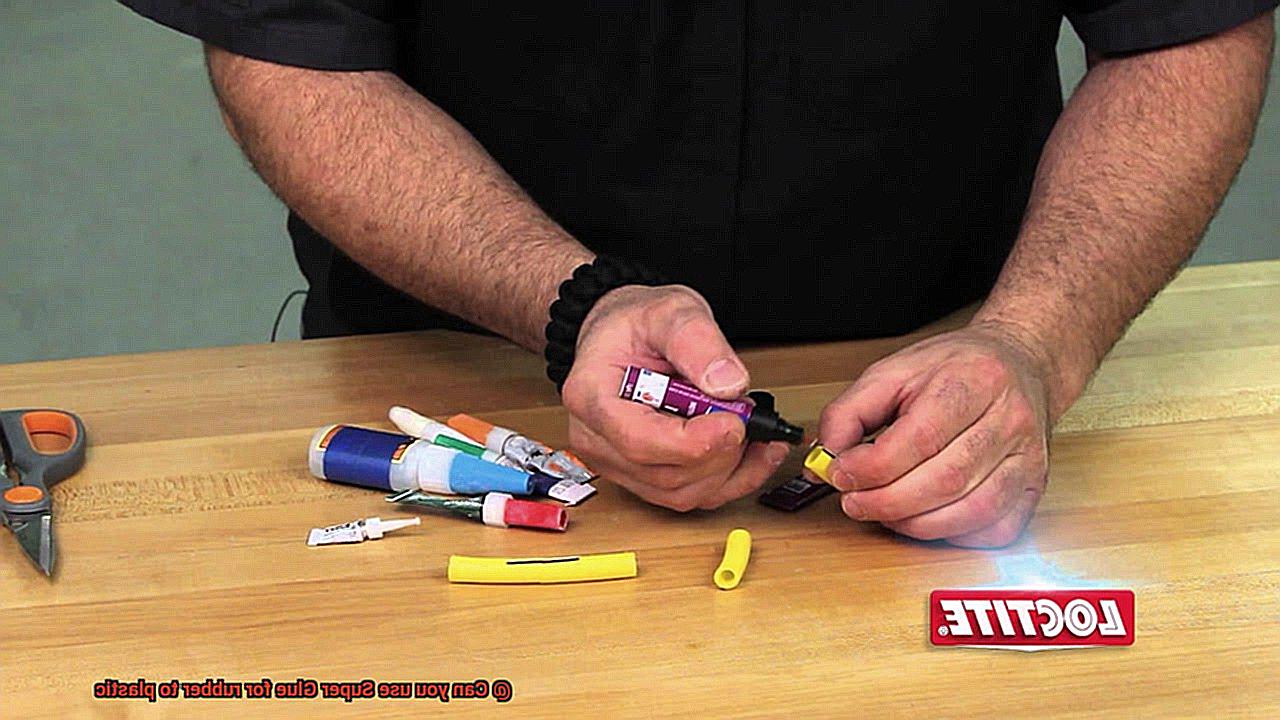
Adhesive Selection:
Choosing the right adhesive is key to successful bonding. While Super Glue (cyanoacrylate adhesive) is widely used due to its fast-drying and strong bonding properties, it may not always be the best choice for rubber-to-plastic bonding. Conducting a compatibility test before applying Super Glue is recommended to ensure a reliable bond.
Compatibility Testing:
To determine the compatibility between rubber and plastic, perform a simple test. Apply a small amount of adhesive on a test piece of both materials and allow it to cure. Assess the strength and durability of the bond after curing. This test will help you determine if Super Glue is suitable or if alternative adhesives are needed.
Surface Preparation:
Proper surface preparation is essential for enhancing adhesion. Thoroughly clean the surfaces to remove any dirt or contaminants that could hinder the bonding process. Additionally, roughening the surfaces through sanding or using a primer specifically designed for rubber-to-plastic bonding can improve adhesion.
Alternative Adhesives:
If Super Glue does not provide the desired bond strength, there are specialized adhesives available on the market that are specifically formulated for rubber-to-plastic bonding. These adhesives offer enhanced bonding capabilities and ensure a reliable and durable bond.
Best Practices for Using Super Glue for Rubber to Plastic Bonding
In this comprehensive guide, we will explore the best practices for using super glue to ensure your rubber to plastic bonding project sticks together seamlessly. Get ready to discover the secrets to successful adhesion.
Prepare the Surfaces:
To achieve a superior bond, proper surface preparation is essential. Begin by cleaning both the rubber and plastic surfaces with a gentle detergent and water solution or rubbing alcohol. This step removes any dirt, dust, or grease that could hinder adhesion. A pristine surface provides a solid foundation for a strong bond.
Roughen the Surfaces:
Smooth rubber and plastic surfaces pose a challenge for adhesion. Overcome this obstacle by using sandpaper or a specialized roughing agent designed for rubber and plastic. Gently roughen the surfaces to create micro-scratches, increasing the contact area for the super glue and enhancing its grip.
Choose the Right Super Glue:
Not all super glues are created equal when it comes to bonding rubber to plastic. Look for a super glue specifically formulated for this purpose, as they often contain additives that optimize adhesion to these materials. Consult the product label or seek guidance from your local hardware store to select the most suitable option.
Apply a Thin and Even Layer:
In the realm of super glue, less is more. Apply a thin and even layer of glue to ensure proper contact between the rubber and plastic surfaces. Excessive glue can lead to messy application and may compromise the strength of the bond. Use an applicator or brush if necessary for precise application.
Apply Pressure During Curing:
To achieve optimal bond strength, exert pressure on the bonded pieces while the glue sets. Clamps are ideal for securing the parts in place during curing. If clamps are not available, improvise by using heavy objects like books or weights to apply pressure. Be cautious not to disturb the bond while it cures.
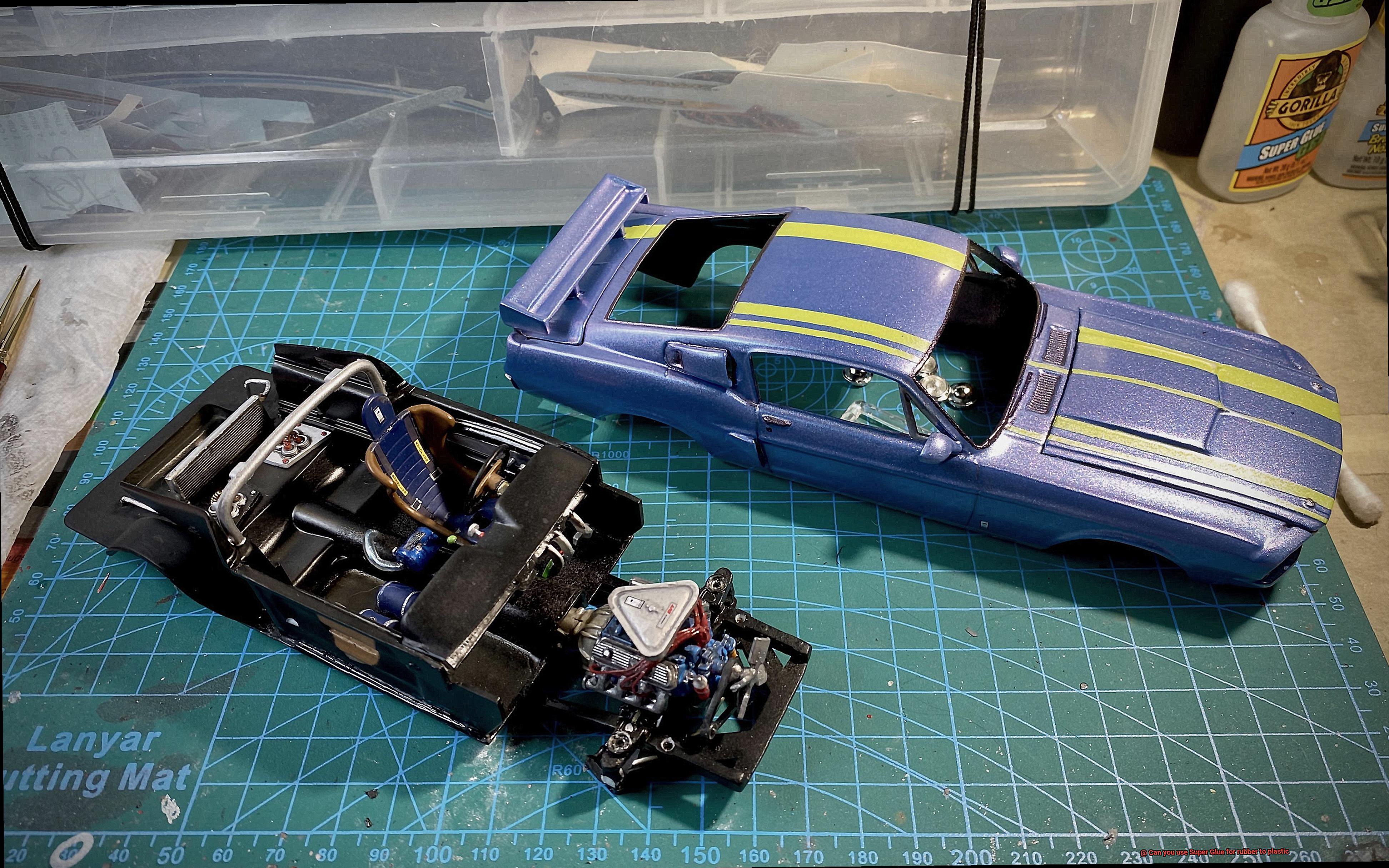
Allow Sufficient Curing Time:
Patience is key. The curing time varies depending on the specific super glue product used. Refer to the manufacturer’s instructions for recommended curing time. Avoid rushing the process and refrain from disturbing the bond until it has fully cured. This ensures a strong and long-lasting bond.
Consider Environmental Factors:
Temperature and humidity play a role in the curing process of super glue. For optimal results, work in a well-ventilated area with controlled temperature and humidity levels. Warm and dry conditions generally facilitate faster curing, so take this into account when planning your project.
Follow Safety Precautions:
Last but not least, prioritize safety. Always follow the manufacturer’s instructions and safety guidelines when using super glue. Wear protective gloves to shield your skin and work in a well-ventilated area to prevent inhaling any potentially harmful fumes associated with the glue.
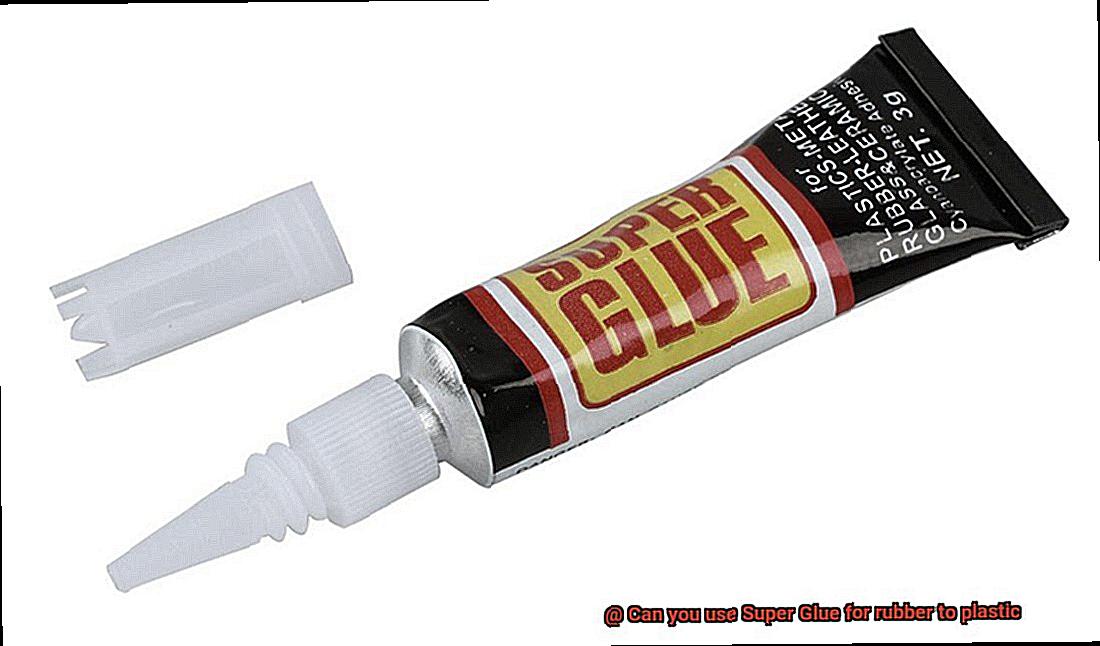
Alternatives to Super Glue for Rubber to Plastic Bonding
When it comes to bonding rubber to plastic, Super Glue may not always be the best choice. However, fear not. There are several alternative adhesives available that can provide a stronger and more durable bond. In this guide, we will explore different options and provide valuable tips to ensure a successful bond between rubber and plastic.
Epoxy Resin:
Known for its unparalleled bonding strength and remarkable versatility, epoxy resin is an excellent choice for rubber to plastic bonding. Its remarkable ability to adhere to various materials, including rubber and plastic, makes it a go-to option. Moreover, it creates a bond that is both strong and durable.
Cyanoacrylate Adhesive (CA Glue):
Similar to Super Glue but with a stronger bond and enhanced resistance to moisture, CA glue is an ideal alternative for rubber to plastic bonding applications. Its ability to create a secure bond ensures the longevity of your project.
Polyurethane Adhesives:
Specifically formulated for rubber to plastic bonding, polyurethane adhesives offer exceptional flexibility and bond strength. They are the perfect solution for applications requiring movement or stress resistance.
Mechanical Fasteners:
In certain cases, screws or clips can serve as suitable alternatives to adhesives. These mechanical fasteners provide a secure and reliable bond without the need for glue. However, it’s crucial to consider the specific requirements of your project before opting for this option.
Surface Preparation:
To achieve optimal adhesion, it’s essential to properly clean rubber and plastic surfaces using rubbing alcohol or a degreaser. Removing any contaminants beforehand ensures better bonding.
Application Tips:
To maximize the effectiveness of the adhesive, carefully follow the manufacturer’s instructions. Apply the adhesive evenly and allow sufficient curing time before subjecting the bond to stress or load.
Testing Bond Strength:
Before relying on the bond for critical applications, it’s advisable to test its strength. Subject the bonded materials to various stresses, such as tension or bending, to ensure the adhesive holds up.
Seek Expert Advice:
For specific recommendations on rubber to plastic bonding, consult with experts or adhesive manufacturers. Their expertise and experience can provide valuable guidance tailored to your project’s needs.
WyM9JtRZuvc” >
Also Read: General Information – Glue Things
Conclusion
In conclusion, while Super Glue may seem like a convenient choice for sticking rubber to plastic, it might not always deliver the strongest and most long-lasting bond. The success of using Super Glue in this scenario depends on several factors, such as the type of rubber and plastic involved, as well as the conditions the bond will face.
It’s crucial to consider the compatibility between rubber and plastic materials and conduct compatibility tests before applying Super Glue. For better results in terms of strength and durability, alternative adhesives specifically designed for rubber-to-plastic bonding, like epoxy adhesives or specialized rubber-to-plastic bonding agents, may be a smarter choice.
Prepping the surfaces properly is key to enhancing adhesion. Make sure to clean and roughen the surfaces before applying a thin and even layer of Super Glue. Applying pressure during curing, allowing ample curing time, and taking into account environmental factors are also essential practices to ensure a successful bond.
If Super Glue doesn’t meet your requirements for rubber to plastic bonding, it’s worth exploring other options like epoxy resin or polyurethane adhesives. Seeking advice from experts or adhesive manufacturers can provide valuable guidance tailored to your specific project needs.
Remember that safety should always come first when working with any adhesive.


